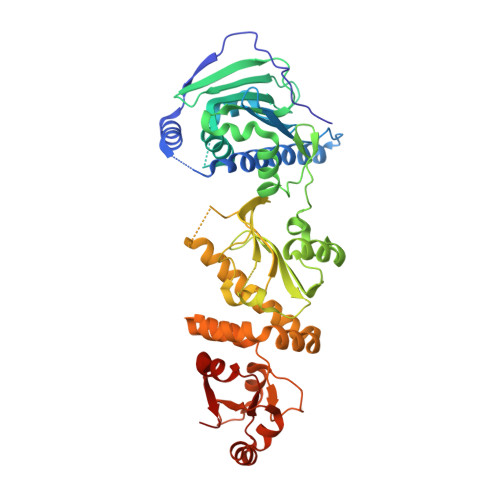Elucidation of novel TRAP1-Selective inhibitors that regulate mitochondrial processes.
Merfeld, T., Peng, S., Keegan, B.M., Crowley, V.M., Brackett, C.M., Gutierrez, A., McCann, N.R., Reynolds, T.S., Rhodes, M.C., Byrd, K.M., Deng, J., Matts, R.L., Blagg, B.S.J.(2023) Eur J Med Chem 258: 115531-115531
- PubMed: 37307624
- DOI: https://doi.org/10.1016/j.ejmech.2023.115531
- Primary Citation of Related Structures:
7U8U, 7U8V, 7U8W, 7U8X - PubMed Abstract:
Hsp90 isoform-selective inhibitors represent a new paradigm for novel anti-cancer drugs as each of the four isoforms have specific cellular localization, function, and client proteins. The mitochondrial isoform, TRAP1, is the least understood member of the Hsp90 family due to the lack of small molecule tools to study its biological function. Herein, we report novel TRAP1-selective inhibitors used to interrogate TRAP1's biological function along with co-crystal structures of such compounds bound to the N-terminus of TRAP1. Solution of the co-crystal structure allowed for a structure-based approach that resulted in compound 36, which is a 40 nM inhibitor with >250-fold TRAP1 selectivity over Grp94, the isoform with the highest structural similarity to TRAP1 within the N-terminal ATP binding site. Lead compounds 35 and 36 were found to selectively induce TRAP1 client protein degradation without inducing the heat shock response or disrupting Hsp90-cytosolic clients. They were also shown to inhibit OXPHOS, alter cellular metabolism towards glycolysis, disrupt TRAP1 tetramer stability, and disrupt the mitochondrial membrane potential.
Organizational Affiliation:
Department of Chemistry and Biochemistry, Warren Family Research Center for Drug Discovery and Development, University of Notre Dame, Notre Dame, IN, 46556, USA.















